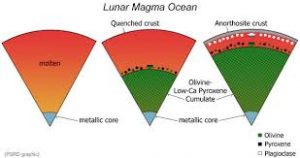Lunar Magma Ocean:

The recent findings from India’s Chandrayaan-3 mission have sparked renewed interest in the Lunar Magma Ocean (LMO) theory, a crucial concept in planetary science that explains the moon’s early formation.
- Chandrayaan-3’s Pragyan rover identified a rock type known as ferroan anorthosite in the lunar south pole region.
- This discovery is significant as it aligns with earlier observations made by the Apollo and Luna missions, confirming the theory that these rocks are remnants of an ancient magma ocean that once covered the moon.
- Lunar Magma Ocean (LMO) is a hypothesized early stage in the moon’s history when its surface was entirely molten.
- This ocean of magma is believed to have formed following a catastrophic impact between the early Earth and a Mars-sized body, leading to the formation of the moon.




